BCAS Academy QS: Laws and Contractual Procedures Assignment Analysis
VerifiedAdded on 2022/03/28
|37
|11564
|61
Homework Assignment
AI Summary
This assignment, focusing on Laws and Contractual Procedures in Quantity Surveying, begins with an acknowledgment of support and guidance received. It introduces the importance of these procedures in the field, covering procurement methods and the roles of quantity surveyors from project design to completion. The assignment is structured into four tasks. Task 1 includes a presentation on nuisance in construction and its mitigation, and a critical analysis of a scenario using the principles of consideration and the case of William v. Roffey Bros. Task 2 delves further into consideration, its definitions, nature, and adequacy, along with the role of seals in contracts. Task 3 expands on these concepts and presents a case study. Task 4 includes a presentation. The document concludes with a summary and references, demonstrating a comprehensive understanding of legal and contractual aspects within the context of quantity surveying.
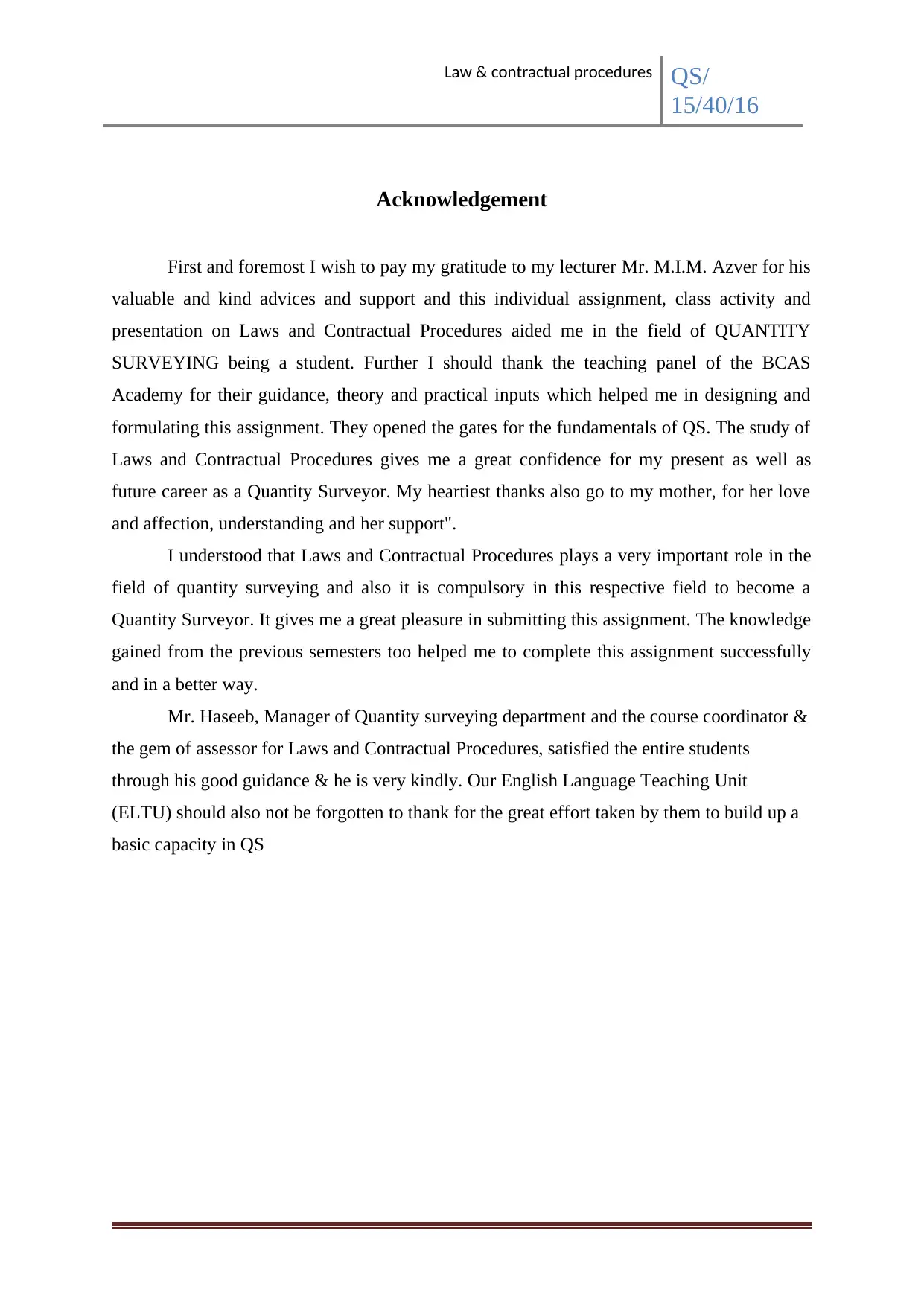
Law & contractual procedures QS/
15/40/16
Acknowledgement
First and foremost I wish to pay my gratitude to my lecturer Mr. M.I.M. Azver for his
valuable and kind advices and support and this individual assignment, class activity and
presentation on Laws and Contractual Procedures aided me in the field of QUANTITY
SURVEYING being a student. Further I should thank the teaching panel of the BCAS
Academy for their guidance, theory and practical inputs which helped me in designing and
formulating this assignment. They opened the gates for the fundamentals of QS. The study of
Laws and Contractual Procedures gives me a great confidence for my present as well as
future career as a Quantity Surveyor. My heartiest thanks also go to my mother, for her love
and affection, understanding and her support".
I understood that Laws and Contractual Procedures plays a very important role in the
field of quantity surveying and also it is compulsory in this respective field to become a
Quantity Surveyor. It gives me a great pleasure in submitting this assignment. The knowledge
gained from the previous semesters too helped me to complete this assignment successfully
and in a better way.
Mr. Haseeb, Manager of Quantity surveying department and the course coordinator &
the gem of assessor for Laws and Contractual Procedures, satisfied the entire students
through his good guidance & he is very kindly. Our English Language Teaching Unit
(ELTU) should also not be forgotten to thank for the great effort taken by them to build up a
basic capacity in QS
15/40/16
Acknowledgement
First and foremost I wish to pay my gratitude to my lecturer Mr. M.I.M. Azver for his
valuable and kind advices and support and this individual assignment, class activity and
presentation on Laws and Contractual Procedures aided me in the field of QUANTITY
SURVEYING being a student. Further I should thank the teaching panel of the BCAS
Academy for their guidance, theory and practical inputs which helped me in designing and
formulating this assignment. They opened the gates for the fundamentals of QS. The study of
Laws and Contractual Procedures gives me a great confidence for my present as well as
future career as a Quantity Surveyor. My heartiest thanks also go to my mother, for her love
and affection, understanding and her support".
I understood that Laws and Contractual Procedures plays a very important role in the
field of quantity surveying and also it is compulsory in this respective field to become a
Quantity Surveyor. It gives me a great pleasure in submitting this assignment. The knowledge
gained from the previous semesters too helped me to complete this assignment successfully
and in a better way.
Mr. Haseeb, Manager of Quantity surveying department and the course coordinator &
the gem of assessor for Laws and Contractual Procedures, satisfied the entire students
through his good guidance & he is very kindly. Our English Language Teaching Unit
(ELTU) should also not be forgotten to thank for the great effort taken by them to build up a
basic capacity in QS
Paraphrase This Document
Need a fresh take? Get an instant paraphrase of this document with our AI Paraphraser
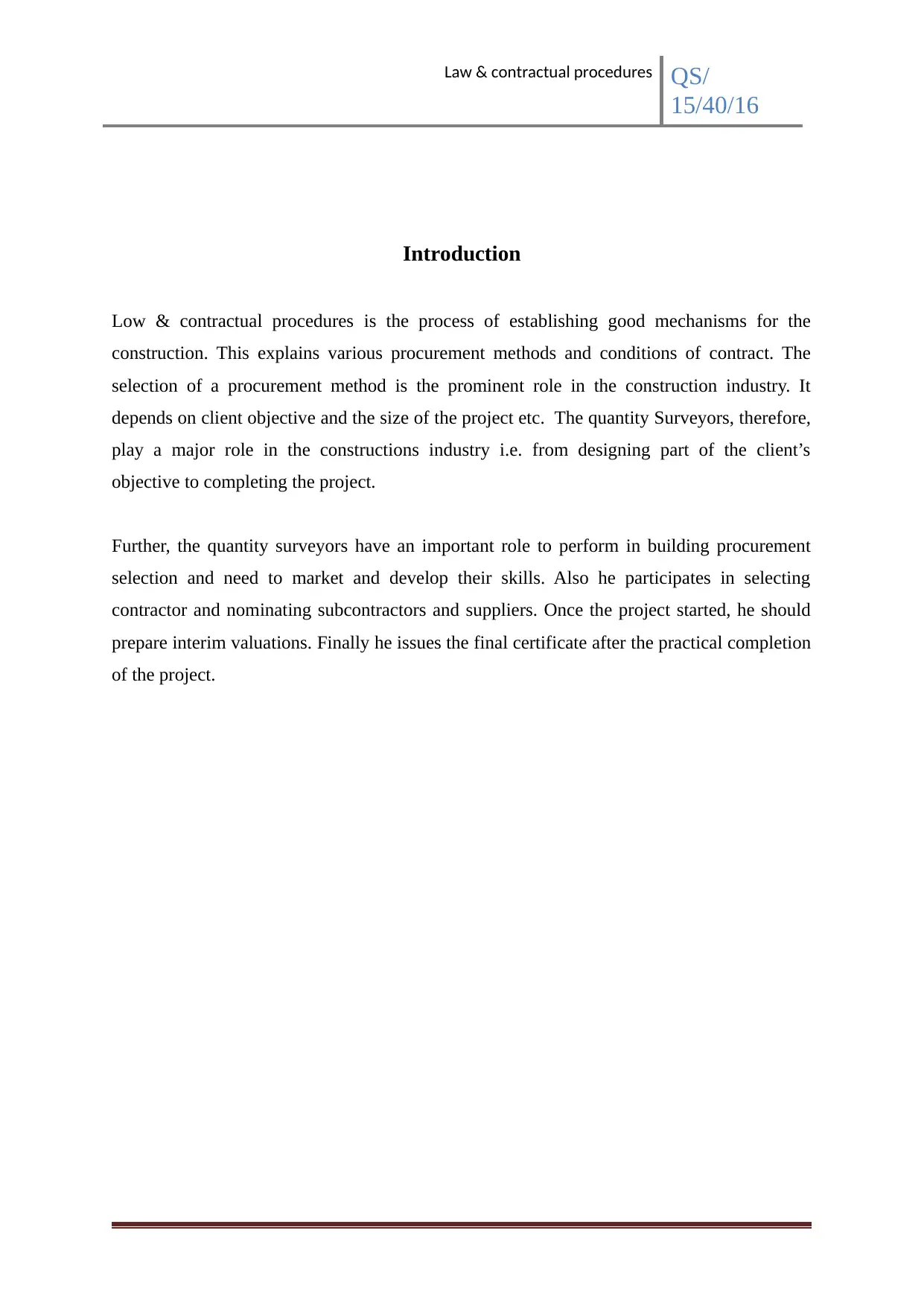
Law & contractual procedures QS/
15/40/16
Introduction
Low & contractual procedures is the process of establishing good mechanisms for the
construction. This explains various procurement methods and conditions of contract. The
selection of a procurement method is the prominent role in the construction industry. It
depends on client objective and the size of the project etc. The quantity Surveyors, therefore,
play a major role in the constructions industry i.e. from designing part of the client’s
objective to completing the project.
Further, the quantity surveyors have an important role to perform in building procurement
selection and need to market and develop their skills. Also he participates in selecting
contractor and nominating subcontractors and suppliers. Once the project started, he should
prepare interim valuations. Finally he issues the final certificate after the practical completion
of the project.
15/40/16
Introduction
Low & contractual procedures is the process of establishing good mechanisms for the
construction. This explains various procurement methods and conditions of contract. The
selection of a procurement method is the prominent role in the construction industry. It
depends on client objective and the size of the project etc. The quantity Surveyors, therefore,
play a major role in the constructions industry i.e. from designing part of the client’s
objective to completing the project.
Further, the quantity surveyors have an important role to perform in building procurement
selection and need to market and develop their skills. Also he participates in selecting
contractor and nominating subcontractors and suppliers. Once the project started, he should
prepare interim valuations. Finally he issues the final certificate after the practical completion
of the project.
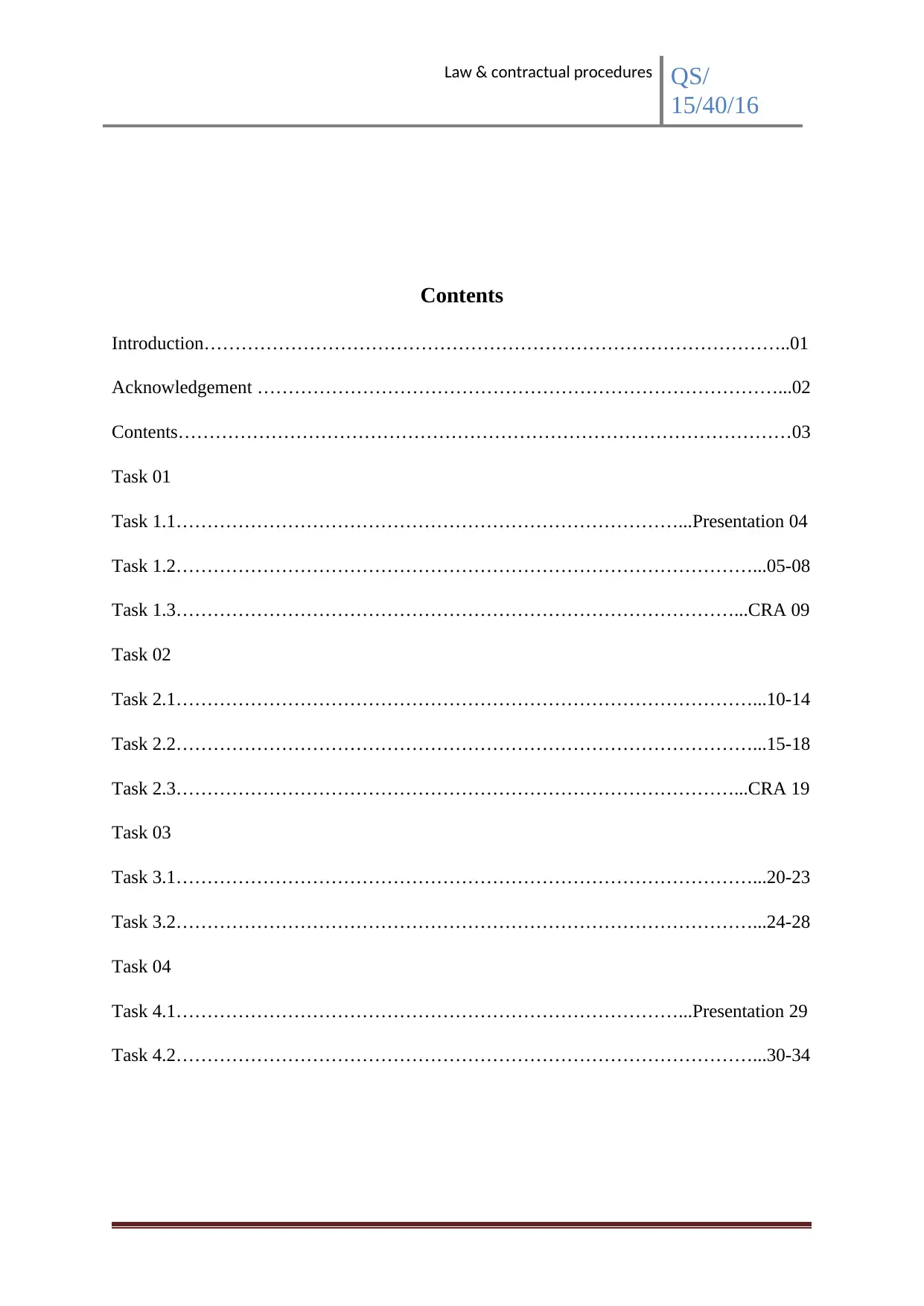
Law & contractual procedures QS/
15/40/16
Contents
Introduction…………………………………………………………………………………..01
Acknowledgement …………………………………………………………………………...02
Contents………………………………………………………………………………………03
Task 01
Task 1.1………………………………………………………………………...Presentation 04
Task 1.2…………………………………………………………………………………...05-08
Task 1.3………………………………………………………………………………...CRA 09
Task 02
Task 2.1…………………………………………………………………………………...10-14
Task 2.2…………………………………………………………………………………...15-18
Task 2.3………………………………………………………………………………...CRA 19
Task 03
Task 3.1…………………………………………………………………………………...20-23
Task 3.2…………………………………………………………………………………...24-28
Task 04
Task 4.1………………………………………………………………………...Presentation 29
Task 4.2…………………………………………………………………………………...30-34
15/40/16
Contents
Introduction…………………………………………………………………………………..01
Acknowledgement …………………………………………………………………………...02
Contents………………………………………………………………………………………03
Task 01
Task 1.1………………………………………………………………………...Presentation 04
Task 1.2…………………………………………………………………………………...05-08
Task 1.3………………………………………………………………………………...CRA 09
Task 02
Task 2.1…………………………………………………………………………………...10-14
Task 2.2…………………………………………………………………………………...15-18
Task 2.3………………………………………………………………………………...CRA 19
Task 03
Task 3.1…………………………………………………………………………………...20-23
Task 3.2…………………………………………………………………………………...24-28
Task 04
Task 4.1………………………………………………………………………...Presentation 29
Task 4.2…………………………………………………………………………………...30-34
⊘ This is a preview!⊘
Do you want full access?
Subscribe today to unlock all pages.

Trusted by 1+ million students worldwide
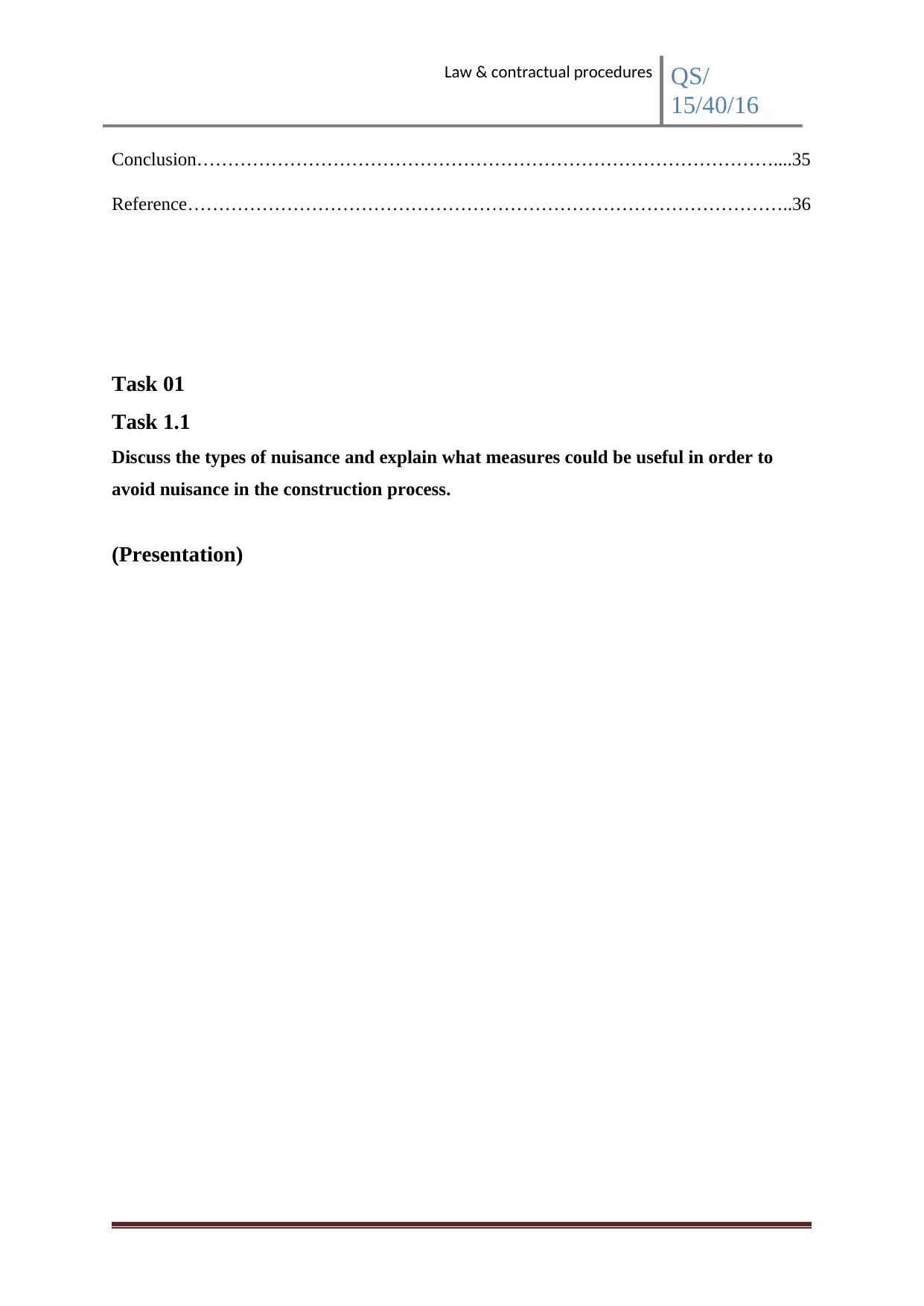
Law & contractual procedures QS/
15/40/16
Conclusion…………………………………………………………………………………....35
Reference……………………………………………………………………………………..36
Task 01
Task 1.1
Discuss the types of nuisance and explain what measures could be useful in order to
avoid nuisance in the construction process.
(Presentation)
15/40/16
Conclusion…………………………………………………………………………………....35
Reference……………………………………………………………………………………..36
Task 01
Task 1.1
Discuss the types of nuisance and explain what measures could be useful in order to
avoid nuisance in the construction process.
(Presentation)
Paraphrase This Document
Need a fresh take? Get an instant paraphrase of this document with our AI Paraphraser
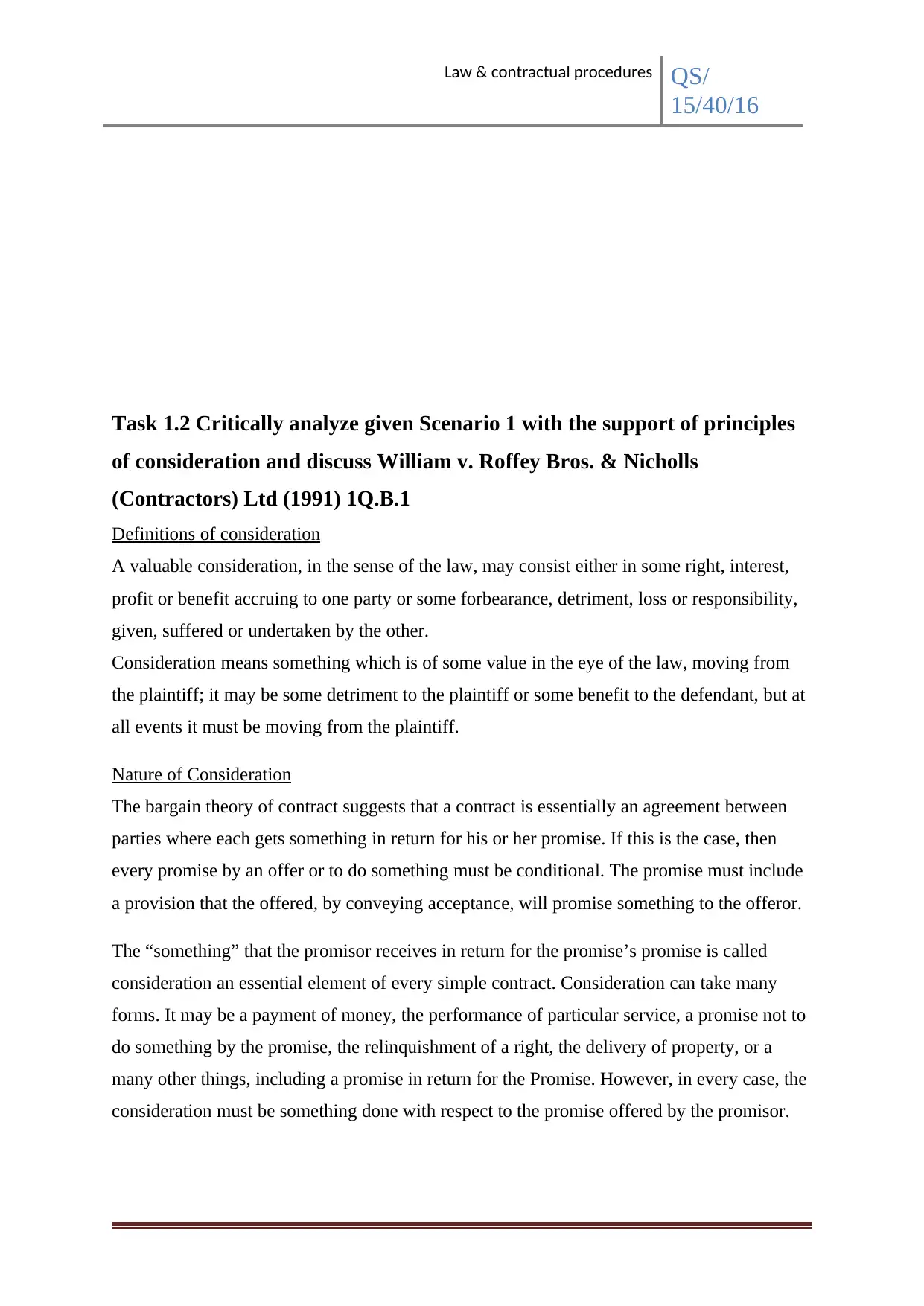
Law & contractual procedures QS/
15/40/16
Task 1.2 Critically analyze given Scenario 1 with the support of principles
of consideration and discuss William v. Roffey Bros. & Nicholls
(Contractors) Ltd (1991) 1Q.B.1
Definitions of consideration
A valuable consideration, in the sense of the law, may consist either in some right, interest,
profit or benefit accruing to one party or some forbearance, detriment, loss or responsibility,
given, suffered or undertaken by the other.
Consideration means something which is of some value in the eye of the law, moving from
the plaintiff; it may be some detriment to the plaintiff or some benefit to the defendant, but at
all events it must be moving from the plaintiff.
Nature of Consideration
The bargain theory of contract suggests that a contract is essentially an agreement between
parties where each gets something in return for his or her promise. If this is the case, then
every promise by an offer or to do something must be conditional. The promise must include
a provision that the offered, by conveying acceptance, will promise something to the offeror.
The “something” that the promisor receives in return for the promise’s promise is called
consideration an essential element of every simple contract. Consideration can take many
forms. It may be a payment of money, the performance of particular service, a promise not to
do something by the promise, the relinquishment of a right, the delivery of property, or a
many other things, including a promise in return for the Promise. However, in every case, the
consideration must be something done with respect to the promise offered by the promisor.
15/40/16
Task 1.2 Critically analyze given Scenario 1 with the support of principles
of consideration and discuss William v. Roffey Bros. & Nicholls
(Contractors) Ltd (1991) 1Q.B.1
Definitions of consideration
A valuable consideration, in the sense of the law, may consist either in some right, interest,
profit or benefit accruing to one party or some forbearance, detriment, loss or responsibility,
given, suffered or undertaken by the other.
Consideration means something which is of some value in the eye of the law, moving from
the plaintiff; it may be some detriment to the plaintiff or some benefit to the defendant, but at
all events it must be moving from the plaintiff.
Nature of Consideration
The bargain theory of contract suggests that a contract is essentially an agreement between
parties where each gets something in return for his or her promise. If this is the case, then
every promise by an offer or to do something must be conditional. The promise must include
a provision that the offered, by conveying acceptance, will promise something to the offeror.
The “something” that the promisor receives in return for the promise’s promise is called
consideration an essential element of every simple contract. Consideration can take many
forms. It may be a payment of money, the performance of particular service, a promise not to
do something by the promise, the relinquishment of a right, the delivery of property, or a
many other things, including a promise in return for the Promise. However, in every case, the
consideration must be something done with respect to the promise offered by the promisor.
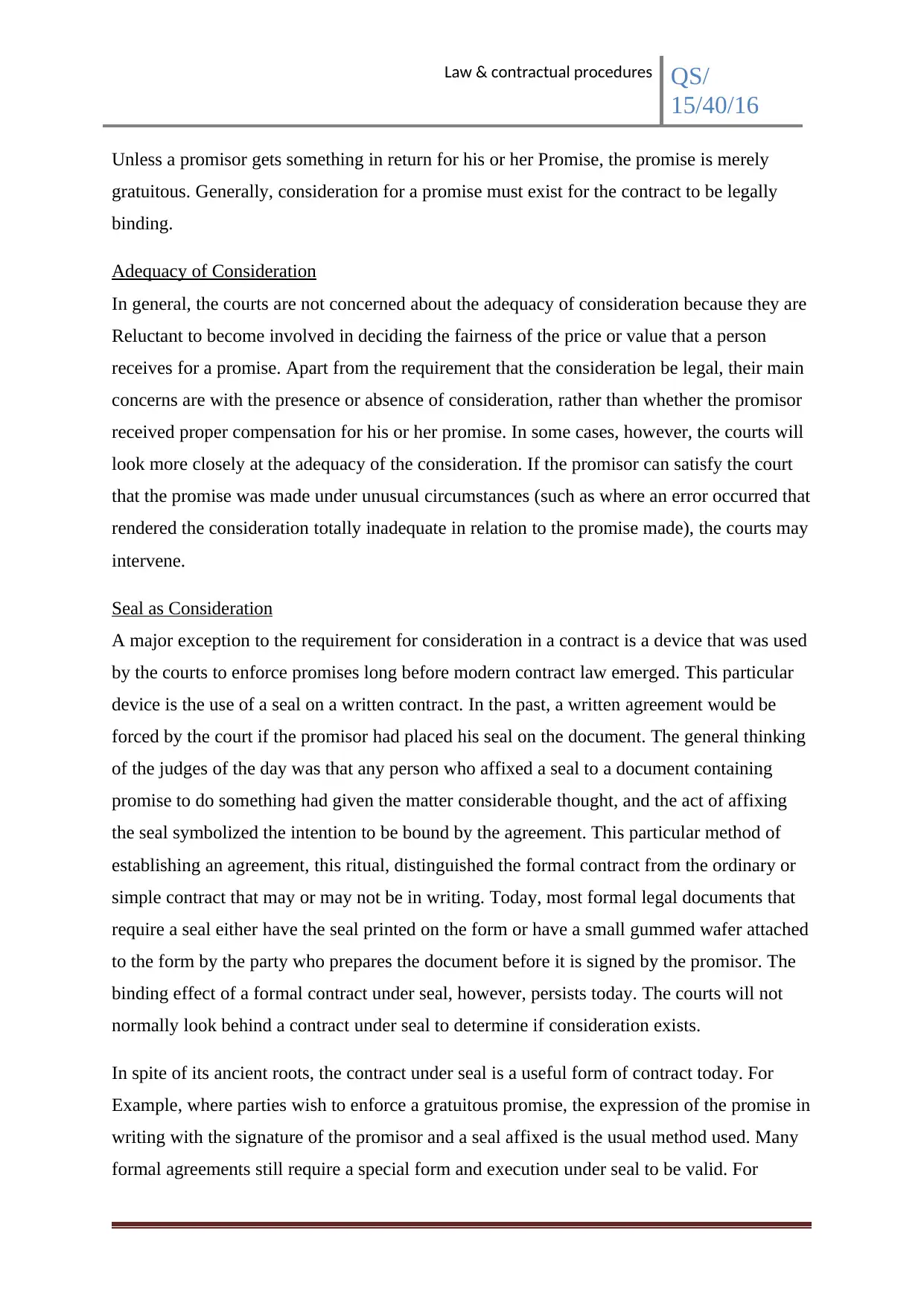
Law & contractual procedures QS/
15/40/16
Unless a promisor gets something in return for his or her Promise, the promise is merely
gratuitous. Generally, consideration for a promise must exist for the contract to be legally
binding.
Adequacy of Consideration
In general, the courts are not concerned about the adequacy of consideration because they are
Reluctant to become involved in deciding the fairness of the price or value that a person
receives for a promise. Apart from the requirement that the consideration be legal, their main
concerns are with the presence or absence of consideration, rather than whether the promisor
received proper compensation for his or her promise. In some cases, however, the courts will
look more closely at the adequacy of the consideration. If the promisor can satisfy the court
that the promise was made under unusual circumstances (such as where an error occurred that
rendered the consideration totally inadequate in relation to the promise made), the courts may
intervene.
Seal as Consideration
A major exception to the requirement for consideration in a contract is a device that was used
by the courts to enforce promises long before modern contract law emerged. This particular
device is the use of a seal on a written contract. In the past, a written agreement would be
forced by the court if the promisor had placed his seal on the document. The general thinking
of the judges of the day was that any person who affixed a seal to a document containing
promise to do something had given the matter considerable thought, and the act of affixing
the seal symbolized the intention to be bound by the agreement. This particular method of
establishing an agreement, this ritual, distinguished the formal contract from the ordinary or
simple contract that may or may not be in writing. Today, most formal legal documents that
require a seal either have the seal printed on the form or have a small gummed wafer attached
to the form by the party who prepares the document before it is signed by the promisor. The
binding effect of a formal contract under seal, however, persists today. The courts will not
normally look behind a contract under seal to determine if consideration exists.
In spite of its ancient roots, the contract under seal is a useful form of contract today. For
Example, where parties wish to enforce a gratuitous promise, the expression of the promise in
writing with the signature of the promisor and a seal affixed is the usual method used. Many
formal agreements still require a special form and execution under seal to be valid. For
15/40/16
Unless a promisor gets something in return for his or her Promise, the promise is merely
gratuitous. Generally, consideration for a promise must exist for the contract to be legally
binding.
Adequacy of Consideration
In general, the courts are not concerned about the adequacy of consideration because they are
Reluctant to become involved in deciding the fairness of the price or value that a person
receives for a promise. Apart from the requirement that the consideration be legal, their main
concerns are with the presence or absence of consideration, rather than whether the promisor
received proper compensation for his or her promise. In some cases, however, the courts will
look more closely at the adequacy of the consideration. If the promisor can satisfy the court
that the promise was made under unusual circumstances (such as where an error occurred that
rendered the consideration totally inadequate in relation to the promise made), the courts may
intervene.
Seal as Consideration
A major exception to the requirement for consideration in a contract is a device that was used
by the courts to enforce promises long before modern contract law emerged. This particular
device is the use of a seal on a written contract. In the past, a written agreement would be
forced by the court if the promisor had placed his seal on the document. The general thinking
of the judges of the day was that any person who affixed a seal to a document containing
promise to do something had given the matter considerable thought, and the act of affixing
the seal symbolized the intention to be bound by the agreement. This particular method of
establishing an agreement, this ritual, distinguished the formal contract from the ordinary or
simple contract that may or may not be in writing. Today, most formal legal documents that
require a seal either have the seal printed on the form or have a small gummed wafer attached
to the form by the party who prepares the document before it is signed by the promisor. The
binding effect of a formal contract under seal, however, persists today. The courts will not
normally look behind a contract under seal to determine if consideration exists.
In spite of its ancient roots, the contract under seal is a useful form of contract today. For
Example, where parties wish to enforce a gratuitous promise, the expression of the promise in
writing with the signature of the promisor and a seal affixed is the usual method used. Many
formal agreements still require a special form and execution under seal to be valid. For
⊘ This is a preview!⊘
Do you want full access?
Subscribe today to unlock all pages.

Trusted by 1+ million students worldwide
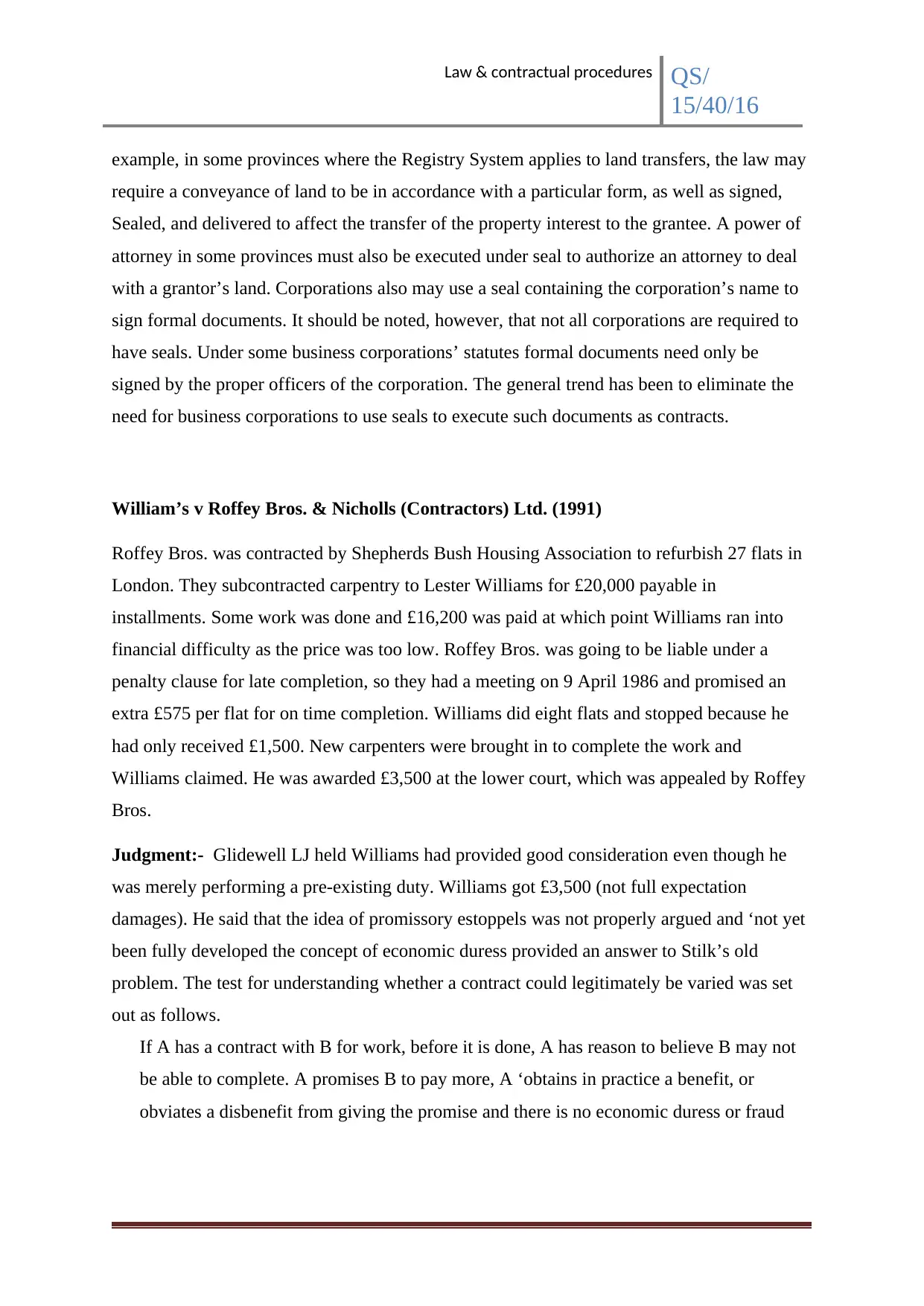
Law & contractual procedures QS/
15/40/16
example, in some provinces where the Registry System applies to land transfers, the law may
require a conveyance of land to be in accordance with a particular form, as well as signed,
Sealed, and delivered to affect the transfer of the property interest to the grantee. A power of
attorney in some provinces must also be executed under seal to authorize an attorney to deal
with a grantor’s land. Corporations also may use a seal containing the corporation’s name to
sign formal documents. It should be noted, however, that not all corporations are required to
have seals. Under some business corporations’ statutes formal documents need only be
signed by the proper officers of the corporation. The general trend has been to eliminate the
need for business corporations to use seals to execute such documents as contracts.
William’s v Roffey Bros. & Nicholls (Contractors) Ltd. (1991)
Roffey Bros. was contracted by Shepherds Bush Housing Association to refurbish 27 flats in
London. They subcontracted carpentry to Lester Williams for £20,000 payable in
installments. Some work was done and £16,200 was paid at which point Williams ran into
financial difficulty as the price was too low. Roffey Bros. was going to be liable under a
penalty clause for late completion, so they had a meeting on 9 April 1986 and promised an
extra £575 per flat for on time completion. Williams did eight flats and stopped because he
had only received £1,500. New carpenters were brought in to complete the work and
Williams claimed. He was awarded £3,500 at the lower court, which was appealed by Roffey
Bros.
Judgment:- Glidewell LJ held Williams had provided good consideration even though he
was merely performing a pre-existing duty. Williams got £3,500 (not full expectation
damages). He said that the idea of promissory estoppels was not properly argued and ‘not yet
been fully developed the concept of economic duress provided an answer to Stilk’s old
problem. The test for understanding whether a contract could legitimately be varied was set
out as follows.
If A has a contract with B for work, before it is done, A has reason to believe B may not
be able to complete. A promises B to pay more, A ‘obtains in practice a benefit, or
obviates a disbenefit from giving the promise and there is no economic duress or fraud
15/40/16
example, in some provinces where the Registry System applies to land transfers, the law may
require a conveyance of land to be in accordance with a particular form, as well as signed,
Sealed, and delivered to affect the transfer of the property interest to the grantee. A power of
attorney in some provinces must also be executed under seal to authorize an attorney to deal
with a grantor’s land. Corporations also may use a seal containing the corporation’s name to
sign formal documents. It should be noted, however, that not all corporations are required to
have seals. Under some business corporations’ statutes formal documents need only be
signed by the proper officers of the corporation. The general trend has been to eliminate the
need for business corporations to use seals to execute such documents as contracts.
William’s v Roffey Bros. & Nicholls (Contractors) Ltd. (1991)
Roffey Bros. was contracted by Shepherds Bush Housing Association to refurbish 27 flats in
London. They subcontracted carpentry to Lester Williams for £20,000 payable in
installments. Some work was done and £16,200 was paid at which point Williams ran into
financial difficulty as the price was too low. Roffey Bros. was going to be liable under a
penalty clause for late completion, so they had a meeting on 9 April 1986 and promised an
extra £575 per flat for on time completion. Williams did eight flats and stopped because he
had only received £1,500. New carpenters were brought in to complete the work and
Williams claimed. He was awarded £3,500 at the lower court, which was appealed by Roffey
Bros.
Judgment:- Glidewell LJ held Williams had provided good consideration even though he
was merely performing a pre-existing duty. Williams got £3,500 (not full expectation
damages). He said that the idea of promissory estoppels was not properly argued and ‘not yet
been fully developed the concept of economic duress provided an answer to Stilk’s old
problem. The test for understanding whether a contract could legitimately be varied was set
out as follows.
If A has a contract with B for work, before it is done, A has reason to believe B may not
be able to complete. A promises B to pay more, A ‘obtains in practice a benefit, or
obviates a disbenefit from giving the promise and there is no economic duress or fraud
Paraphrase This Document
Need a fresh take? Get an instant paraphrase of this document with our AI Paraphraser
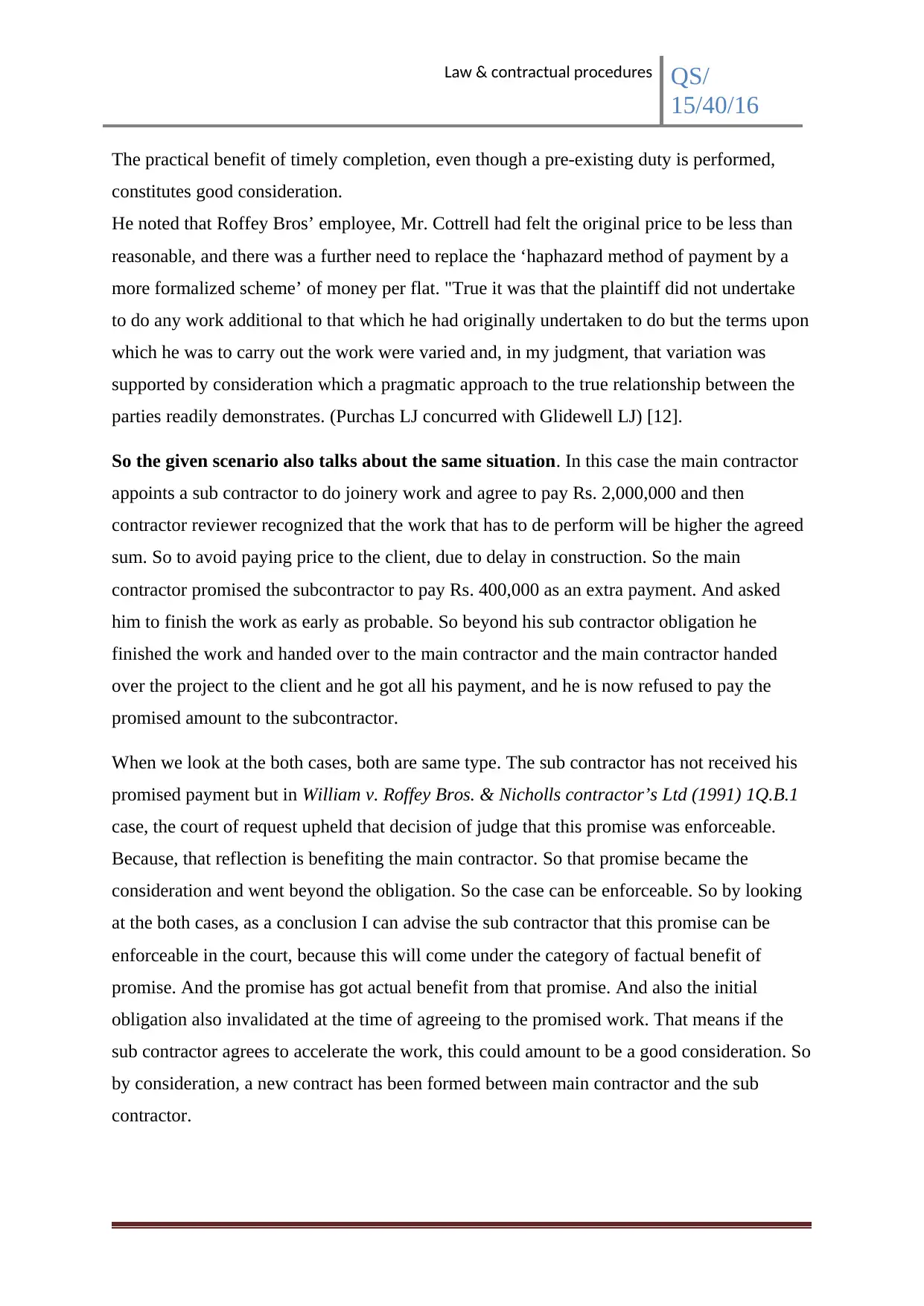
Law & contractual procedures QS/
15/40/16
The practical benefit of timely completion, even though a pre-existing duty is performed,
constitutes good consideration.
He noted that Roffey Bros’ employee, Mr. Cottrell had felt the original price to be less than
reasonable, and there was a further need to replace the ‘haphazard method of payment by a
more formalized scheme’ of money per flat. "True it was that the plaintiff did not undertake
to do any work additional to that which he had originally undertaken to do but the terms upon
which he was to carry out the work were varied and, in my judgment, that variation was
supported by consideration which a pragmatic approach to the true relationship between the
parties readily demonstrates. (Purchas LJ concurred with Glidewell LJ) [12].
So the given scenario also talks about the same situation. In this case the main contractor
appoints a sub contractor to do joinery work and agree to pay Rs. 2,000,000 and then
contractor reviewer recognized that the work that has to de perform will be higher the agreed
sum. So to avoid paying price to the client, due to delay in construction. So the main
contractor promised the subcontractor to pay Rs. 400,000 as an extra payment. And asked
him to finish the work as early as probable. So beyond his sub contractor obligation he
finished the work and handed over to the main contractor and the main contractor handed
over the project to the client and he got all his payment, and he is now refused to pay the
promised amount to the subcontractor.
When we look at the both cases, both are same type. The sub contractor has not received his
promised payment but in William v. Roffey Bros. & Nicholls contractor’s Ltd (1991) 1Q.B.1
case, the court of request upheld that decision of judge that this promise was enforceable.
Because, that reflection is benefiting the main contractor. So that promise became the
consideration and went beyond the obligation. So the case can be enforceable. So by looking
at the both cases, as a conclusion I can advise the sub contractor that this promise can be
enforceable in the court, because this will come under the category of factual benefit of
promise. And the promise has got actual benefit from that promise. And also the initial
obligation also invalidated at the time of agreeing to the promised work. That means if the
sub contractor agrees to accelerate the work, this could amount to be a good consideration. So
by consideration, a new contract has been formed between main contractor and the sub
contractor.
15/40/16
The practical benefit of timely completion, even though a pre-existing duty is performed,
constitutes good consideration.
He noted that Roffey Bros’ employee, Mr. Cottrell had felt the original price to be less than
reasonable, and there was a further need to replace the ‘haphazard method of payment by a
more formalized scheme’ of money per flat. "True it was that the plaintiff did not undertake
to do any work additional to that which he had originally undertaken to do but the terms upon
which he was to carry out the work were varied and, in my judgment, that variation was
supported by consideration which a pragmatic approach to the true relationship between the
parties readily demonstrates. (Purchas LJ concurred with Glidewell LJ) [12].
So the given scenario also talks about the same situation. In this case the main contractor
appoints a sub contractor to do joinery work and agree to pay Rs. 2,000,000 and then
contractor reviewer recognized that the work that has to de perform will be higher the agreed
sum. So to avoid paying price to the client, due to delay in construction. So the main
contractor promised the subcontractor to pay Rs. 400,000 as an extra payment. And asked
him to finish the work as early as probable. So beyond his sub contractor obligation he
finished the work and handed over to the main contractor and the main contractor handed
over the project to the client and he got all his payment, and he is now refused to pay the
promised amount to the subcontractor.
When we look at the both cases, both are same type. The sub contractor has not received his
promised payment but in William v. Roffey Bros. & Nicholls contractor’s Ltd (1991) 1Q.B.1
case, the court of request upheld that decision of judge that this promise was enforceable.
Because, that reflection is benefiting the main contractor. So that promise became the
consideration and went beyond the obligation. So the case can be enforceable. So by looking
at the both cases, as a conclusion I can advise the sub contractor that this promise can be
enforceable in the court, because this will come under the category of factual benefit of
promise. And the promise has got actual benefit from that promise. And also the initial
obligation also invalidated at the time of agreeing to the promised work. That means if the
sub contractor agrees to accelerate the work, this could amount to be a good consideration. So
by consideration, a new contract has been formed between main contractor and the sub
contractor.
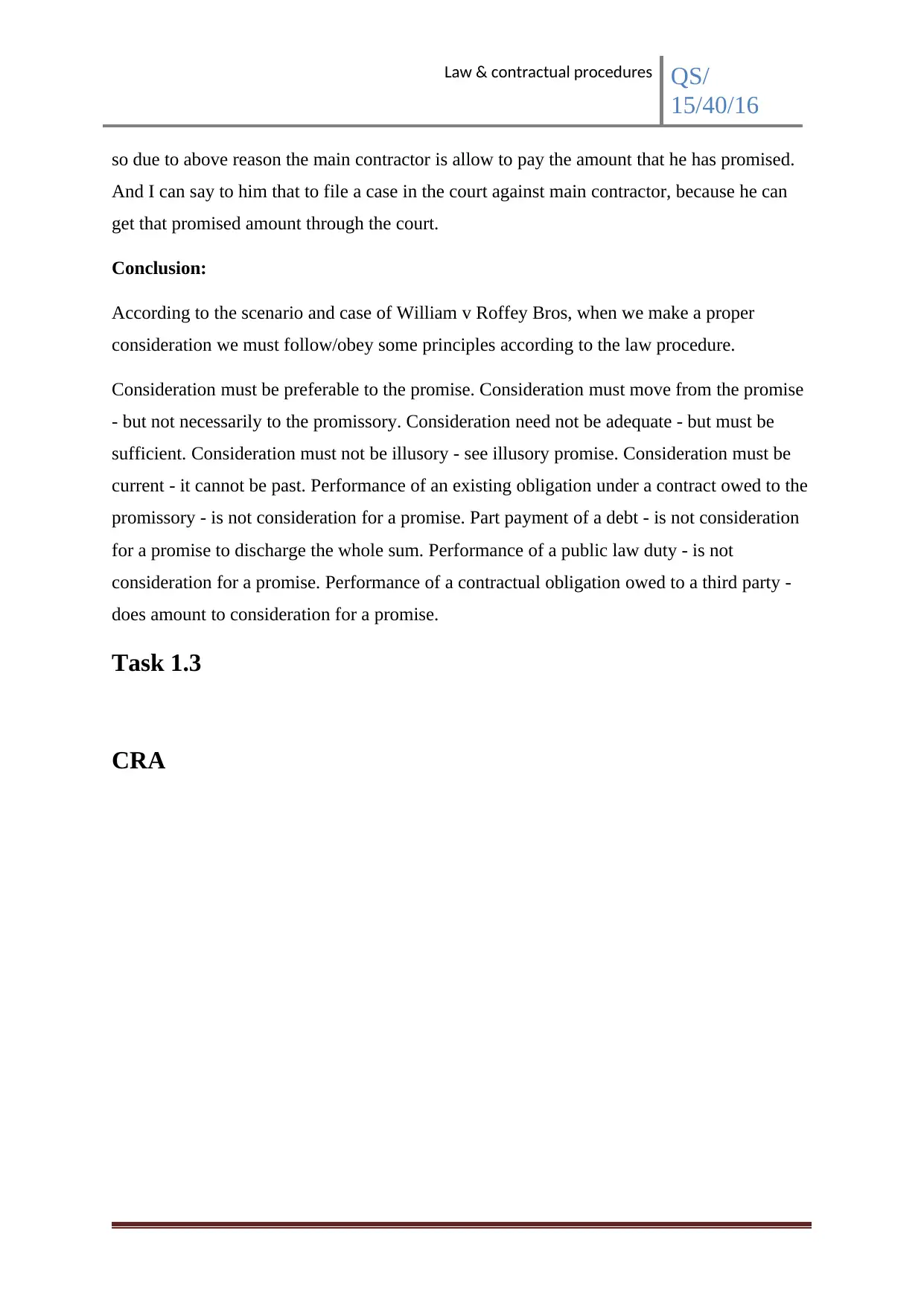
Law & contractual procedures QS/
15/40/16
so due to above reason the main contractor is allow to pay the amount that he has promised.
And I can say to him that to file a case in the court against main contractor, because he can
get that promised amount through the court.
Conclusion:
According to the scenario and case of William v Roffey Bros, when we make a proper
consideration we must follow/obey some principles according to the law procedure.
Consideration must be preferable to the promise. Consideration must move from the promise
- but not necessarily to the promissory. Consideration need not be adequate - but must be
sufficient. Consideration must not be illusory - see illusory promise. Consideration must be
current - it cannot be past. Performance of an existing obligation under a contract owed to the
promissory - is not consideration for a promise. Part payment of a debt - is not consideration
for a promise to discharge the whole sum. Performance of a public law duty - is not
consideration for a promise. Performance of a contractual obligation owed to a third party -
does amount to consideration for a promise.
Task 1.3
CRA
15/40/16
so due to above reason the main contractor is allow to pay the amount that he has promised.
And I can say to him that to file a case in the court against main contractor, because he can
get that promised amount through the court.
Conclusion:
According to the scenario and case of William v Roffey Bros, when we make a proper
consideration we must follow/obey some principles according to the law procedure.
Consideration must be preferable to the promise. Consideration must move from the promise
- but not necessarily to the promissory. Consideration need not be adequate - but must be
sufficient. Consideration must not be illusory - see illusory promise. Consideration must be
current - it cannot be past. Performance of an existing obligation under a contract owed to the
promissory - is not consideration for a promise. Part payment of a debt - is not consideration
for a promise to discharge the whole sum. Performance of a public law duty - is not
consideration for a promise. Performance of a contractual obligation owed to a third party -
does amount to consideration for a promise.
Task 1.3
CRA
⊘ This is a preview!⊘
Do you want full access?
Subscribe today to unlock all pages.

Trusted by 1+ million students worldwide
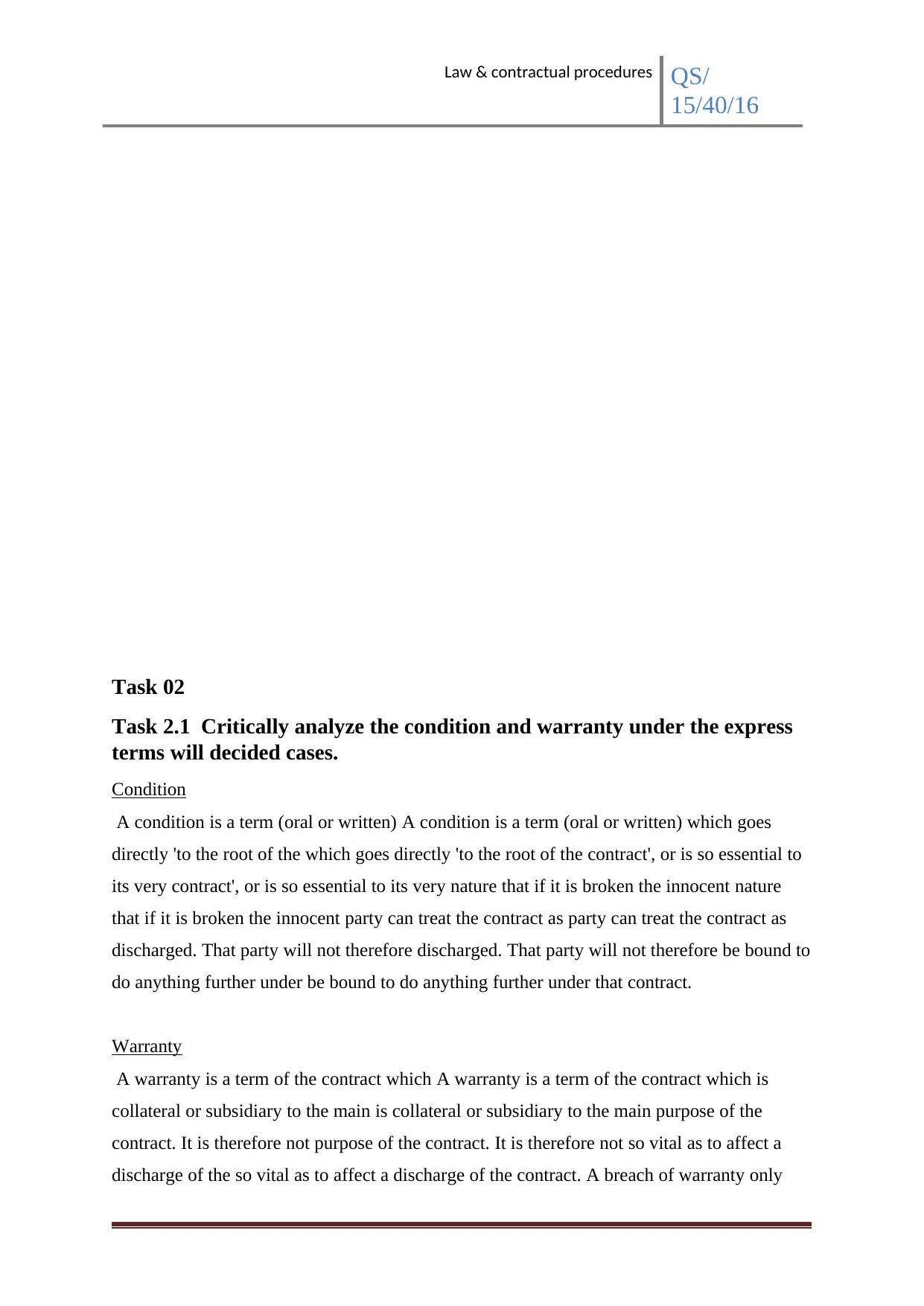
Law & contractual procedures QS/
15/40/16
Task 02
Task 2.1 Critically analyze the condition and warranty under the express
terms will decided cases.
Condition
A condition is a term (oral or written) A condition is a term (oral or written) which goes
directly 'to the root of the which goes directly 'to the root of the contract', or is so essential to
its very contract', or is so essential to its very nature that if it is broken the innocent nature
that if it is broken the innocent party can treat the contract as party can treat the contract as
discharged. That party will not therefore discharged. That party will not therefore be bound to
do anything further under be bound to do anything further under that contract.
Warranty
A warranty is a term of the contract which A warranty is a term of the contract which is
collateral or subsidiary to the main is collateral or subsidiary to the main purpose of the
contract. It is therefore not purpose of the contract. It is therefore not so vital as to affect a
discharge of the so vital as to affect a discharge of the contract. A breach of warranty only
15/40/16
Task 02
Task 2.1 Critically analyze the condition and warranty under the express
terms will decided cases.
Condition
A condition is a term (oral or written) A condition is a term (oral or written) which goes
directly 'to the root of the which goes directly 'to the root of the contract', or is so essential to
its very contract', or is so essential to its very nature that if it is broken the innocent nature
that if it is broken the innocent party can treat the contract as party can treat the contract as
discharged. That party will not therefore discharged. That party will not therefore be bound to
do anything further under be bound to do anything further under that contract.
Warranty
A warranty is a term of the contract which A warranty is a term of the contract which is
collateral or subsidiary to the main is collateral or subsidiary to the main purpose of the
contract. It is therefore not purpose of the contract. It is therefore not so vital as to affect a
discharge of the so vital as to affect a discharge of the contract. A breach of warranty only
Paraphrase This Document
Need a fresh take? Get an instant paraphrase of this document with our AI Paraphraser
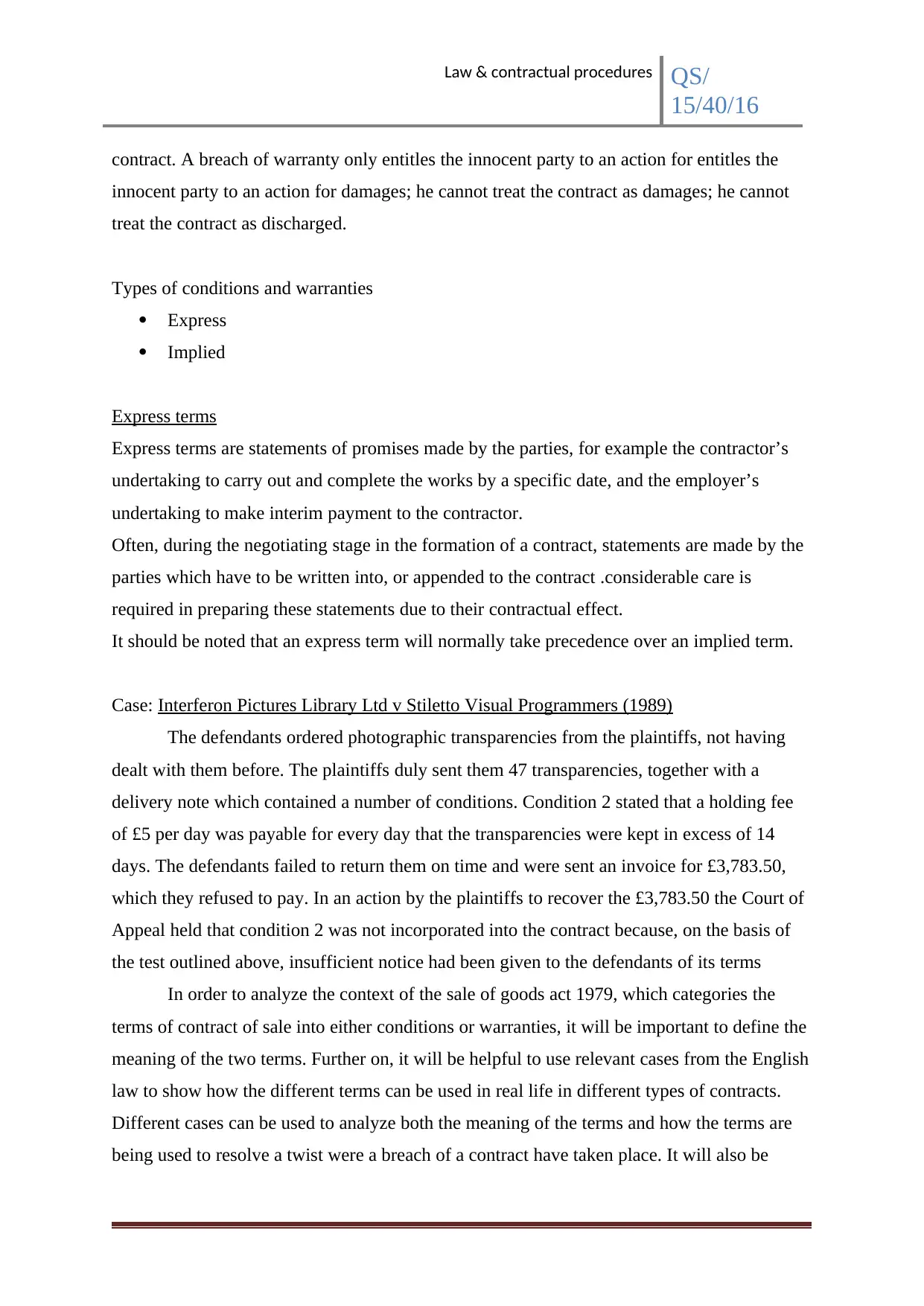
Law & contractual procedures QS/
15/40/16
contract. A breach of warranty only entitles the innocent party to an action for entitles the
innocent party to an action for damages; he cannot treat the contract as damages; he cannot
treat the contract as discharged.
Types of conditions and warranties
Express
Implied
Express terms
Express terms are statements of promises made by the parties, for example the contractor’s
undertaking to carry out and complete the works by a specific date, and the employer’s
undertaking to make interim payment to the contractor.
Often, during the negotiating stage in the formation of a contract, statements are made by the
parties which have to be written into, or appended to the contract .considerable care is
required in preparing these statements due to their contractual effect.
It should be noted that an express term will normally take precedence over an implied term.
Case: Interferon Pictures Library Ltd v Stiletto Visual Programmers (1989)
The defendants ordered photographic transparencies from the plaintiffs, not having
dealt with them before. The plaintiffs duly sent them 47 transparencies, together with a
delivery note which contained a number of conditions. Condition 2 stated that a holding fee
of £5 per day was payable for every day that the transparencies were kept in excess of 14
days. The defendants failed to return them on time and were sent an invoice for £3,783.50,
which they refused to pay. In an action by the plaintiffs to recover the £3,783.50 the Court of
Appeal held that condition 2 was not incorporated into the contract because, on the basis of
the test outlined above, insufficient notice had been given to the defendants of its terms
In order to analyze the context of the sale of goods act 1979, which categories the
terms of contract of sale into either conditions or warranties, it will be important to define the
meaning of the two terms. Further on, it will be helpful to use relevant cases from the English
law to show how the different terms can be used in real life in different types of contracts.
Different cases can be used to analyze both the meaning of the terms and how the terms are
being used to resolve a twist were a breach of a contract have taken place. It will also be
15/40/16
contract. A breach of warranty only entitles the innocent party to an action for entitles the
innocent party to an action for damages; he cannot treat the contract as damages; he cannot
treat the contract as discharged.
Types of conditions and warranties
Express
Implied
Express terms
Express terms are statements of promises made by the parties, for example the contractor’s
undertaking to carry out and complete the works by a specific date, and the employer’s
undertaking to make interim payment to the contractor.
Often, during the negotiating stage in the formation of a contract, statements are made by the
parties which have to be written into, or appended to the contract .considerable care is
required in preparing these statements due to their contractual effect.
It should be noted that an express term will normally take precedence over an implied term.
Case: Interferon Pictures Library Ltd v Stiletto Visual Programmers (1989)
The defendants ordered photographic transparencies from the plaintiffs, not having
dealt with them before. The plaintiffs duly sent them 47 transparencies, together with a
delivery note which contained a number of conditions. Condition 2 stated that a holding fee
of £5 per day was payable for every day that the transparencies were kept in excess of 14
days. The defendants failed to return them on time and were sent an invoice for £3,783.50,
which they refused to pay. In an action by the plaintiffs to recover the £3,783.50 the Court of
Appeal held that condition 2 was not incorporated into the contract because, on the basis of
the test outlined above, insufficient notice had been given to the defendants of its terms
In order to analyze the context of the sale of goods act 1979, which categories the
terms of contract of sale into either conditions or warranties, it will be important to define the
meaning of the two terms. Further on, it will be helpful to use relevant cases from the English
law to show how the different terms can be used in real life in different types of contracts.
Different cases can be used to analyze both the meaning of the terms and how the terms are
being used to resolve a twist were a breach of a contract have taken place. It will also be
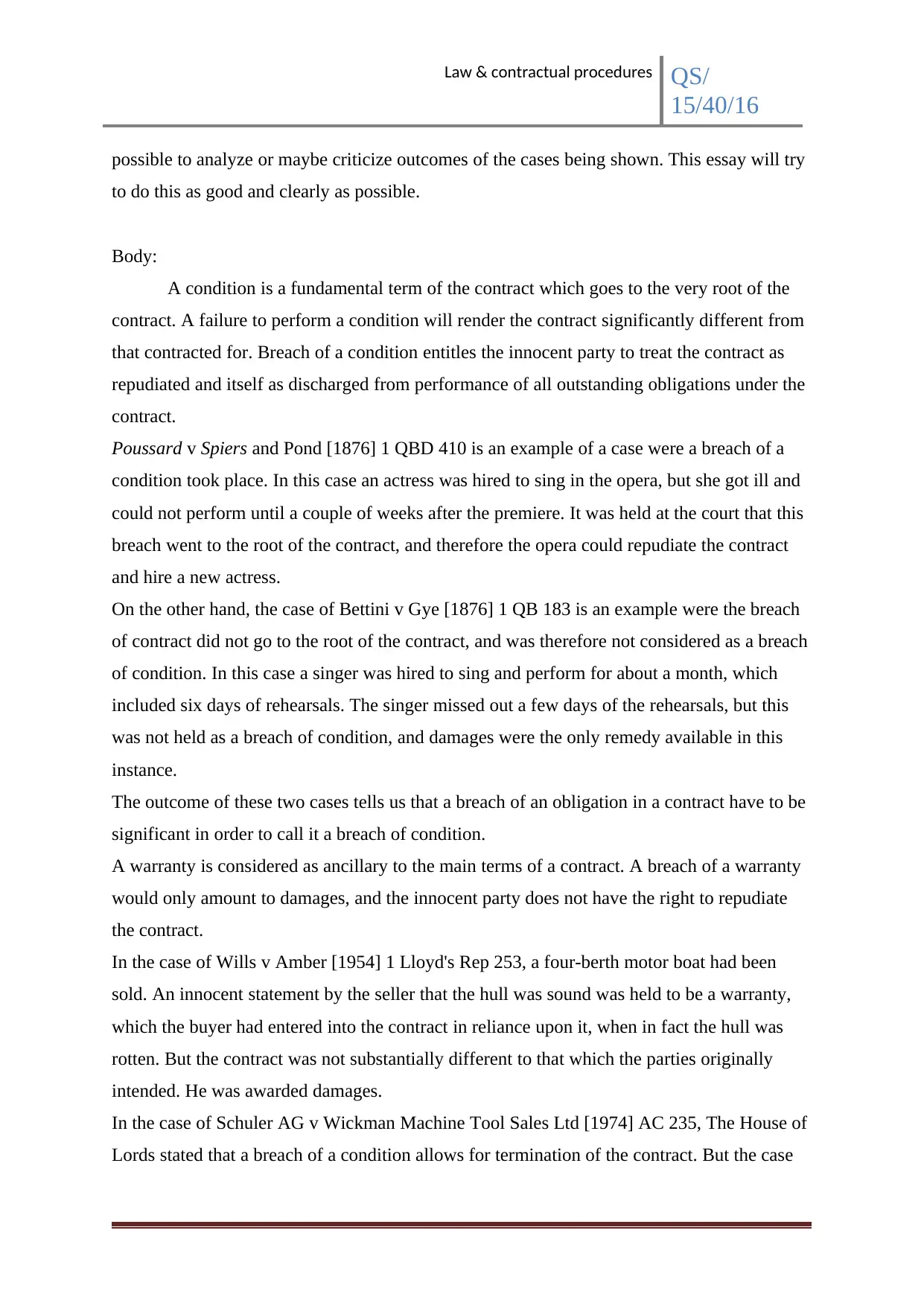
Law & contractual procedures QS/
15/40/16
possible to analyze or maybe criticize outcomes of the cases being shown. This essay will try
to do this as good and clearly as possible.
Body:
A condition is a fundamental term of the contract which goes to the very root of the
contract. A failure to perform a condition will render the contract significantly different from
that contracted for. Breach of a condition entitles the innocent party to treat the contract as
repudiated and itself as discharged from performance of all outstanding obligations under the
contract.
Poussard v Spiers and Pond [1876] 1 QBD 410 is an example of a case were a breach of a
condition took place. In this case an actress was hired to sing in the opera, but she got ill and
could not perform until a couple of weeks after the premiere. It was held at the court that this
breach went to the root of the contract, and therefore the opera could repudiate the contract
and hire a new actress.
On the other hand, the case of Bettini v Gye [1876] 1 QB 183 is an example were the breach
of contract did not go to the root of the contract, and was therefore not considered as a breach
of condition. In this case a singer was hired to sing and perform for about a month, which
included six days of rehearsals. The singer missed out a few days of the rehearsals, but this
was not held as a breach of condition, and damages were the only remedy available in this
instance.
The outcome of these two cases tells us that a breach of an obligation in a contract have to be
significant in order to call it a breach of condition.
A warranty is considered as ancillary to the main terms of a contract. A breach of a warranty
would only amount to damages, and the innocent party does not have the right to repudiate
the contract.
In the case of Wills v Amber [1954] 1 Lloyd's Rep 253, a four-berth motor boat had been
sold. An innocent statement by the seller that the hull was sound was held to be a warranty,
which the buyer had entered into the contract in reliance upon it, when in fact the hull was
rotten. But the contract was not substantially different to that which the parties originally
intended. He was awarded damages.
In the case of Schuler AG v Wickman Machine Tool Sales Ltd [1974] AC 235, The House of
Lords stated that a breach of a condition allows for termination of the contract. But the case
15/40/16
possible to analyze or maybe criticize outcomes of the cases being shown. This essay will try
to do this as good and clearly as possible.
Body:
A condition is a fundamental term of the contract which goes to the very root of the
contract. A failure to perform a condition will render the contract significantly different from
that contracted for. Breach of a condition entitles the innocent party to treat the contract as
repudiated and itself as discharged from performance of all outstanding obligations under the
contract.
Poussard v Spiers and Pond [1876] 1 QBD 410 is an example of a case were a breach of a
condition took place. In this case an actress was hired to sing in the opera, but she got ill and
could not perform until a couple of weeks after the premiere. It was held at the court that this
breach went to the root of the contract, and therefore the opera could repudiate the contract
and hire a new actress.
On the other hand, the case of Bettini v Gye [1876] 1 QB 183 is an example were the breach
of contract did not go to the root of the contract, and was therefore not considered as a breach
of condition. In this case a singer was hired to sing and perform for about a month, which
included six days of rehearsals. The singer missed out a few days of the rehearsals, but this
was not held as a breach of condition, and damages were the only remedy available in this
instance.
The outcome of these two cases tells us that a breach of an obligation in a contract have to be
significant in order to call it a breach of condition.
A warranty is considered as ancillary to the main terms of a contract. A breach of a warranty
would only amount to damages, and the innocent party does not have the right to repudiate
the contract.
In the case of Wills v Amber [1954] 1 Lloyd's Rep 253, a four-berth motor boat had been
sold. An innocent statement by the seller that the hull was sound was held to be a warranty,
which the buyer had entered into the contract in reliance upon it, when in fact the hull was
rotten. But the contract was not substantially different to that which the parties originally
intended. He was awarded damages.
In the case of Schuler AG v Wickman Machine Tool Sales Ltd [1974] AC 235, The House of
Lords stated that a breach of a condition allows for termination of the contract. But the case
⊘ This is a preview!⊘
Do you want full access?
Subscribe today to unlock all pages.

Trusted by 1+ million students worldwide
1 out of 37
Related Documents
Your All-in-One AI-Powered Toolkit for Academic Success.
+13062052269
info@desklib.com
Available 24*7 on WhatsApp / Email
![[object Object]](/_next/static/media/star-bottom.7253800d.svg)
Unlock your academic potential
Copyright © 2020–2025 A2Z Services. All Rights Reserved. Developed and managed by ZUCOL.





